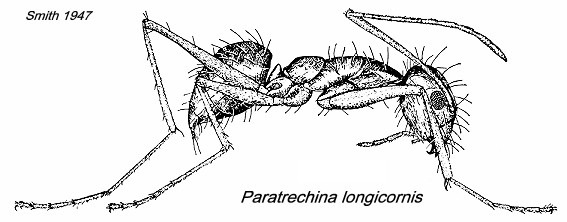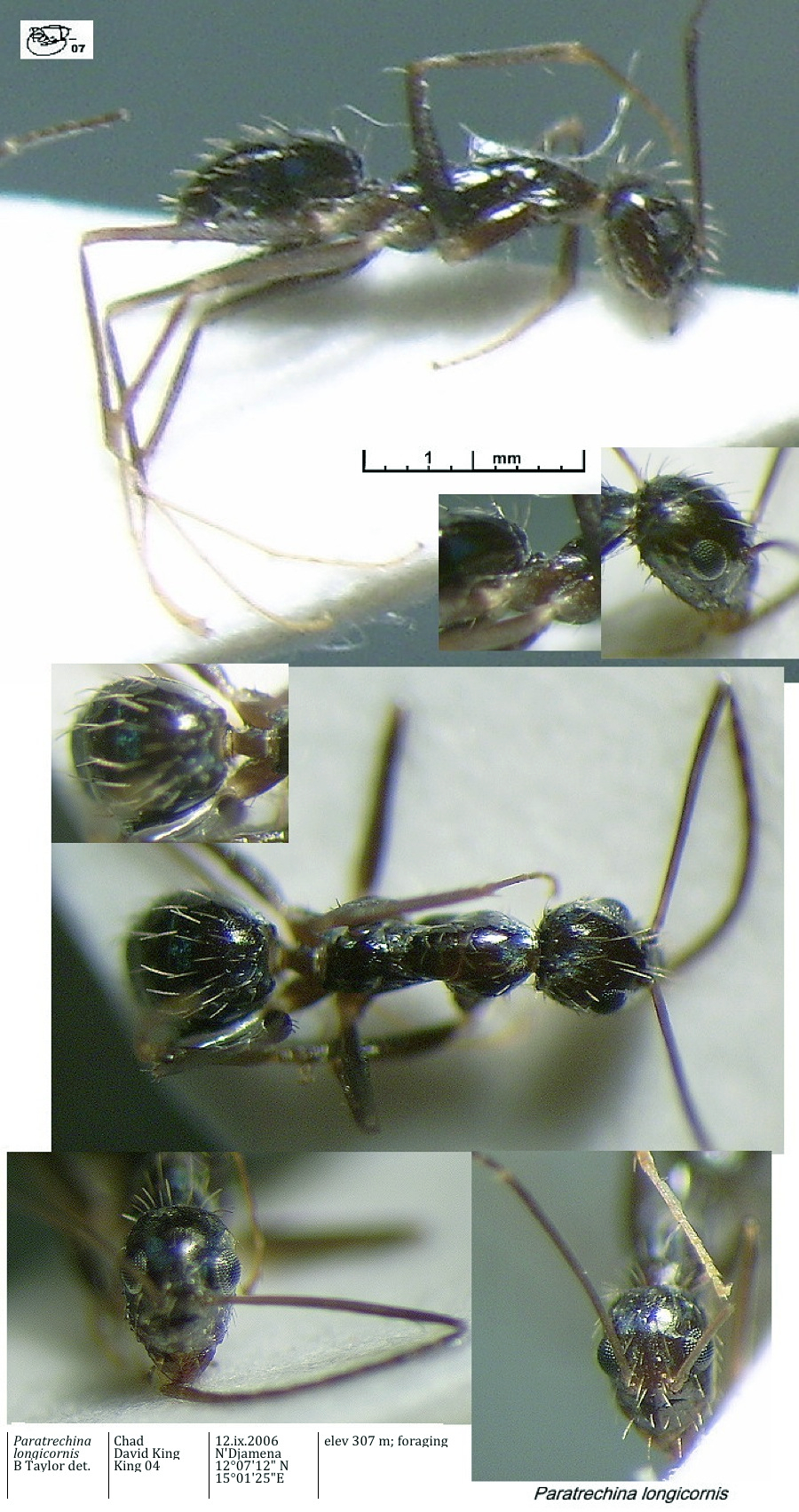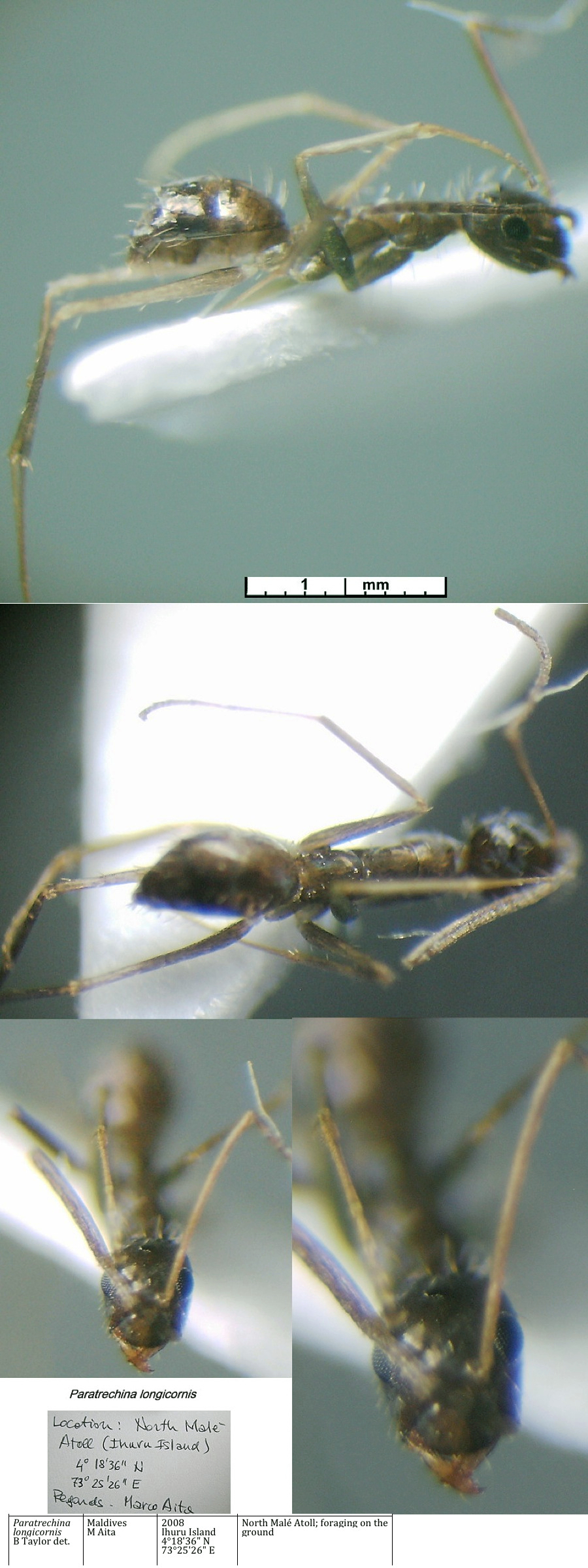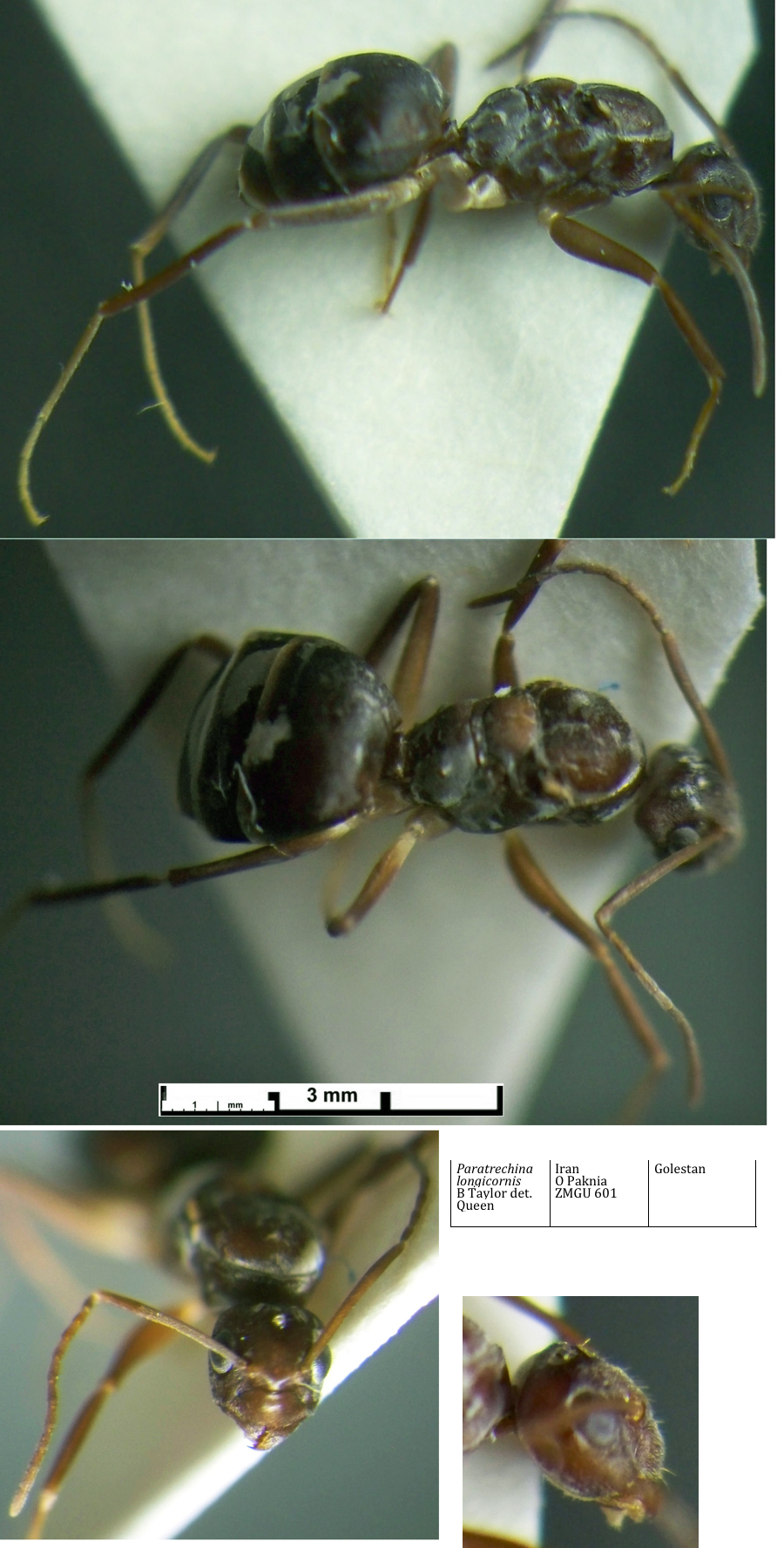Paratrechina
longicornis (Latreille)

 Iran list Iran list
 Type location Senegal (Formica
longicornis, Latreille, 1802c:
113, worker; Formica vagans, Jerdon, 1851: 124,
queen, "exceedingly common in the Carnatic"; André, 1881b: 60, male
(from among Egypt, Syria and Palestine); Prenolepis longicornis
Roger, 1863b: 10) Type location Senegal (Formica
longicornis, Latreille, 1802c:
113, worker; Formica vagans, Jerdon, 1851: 124,
queen, "exceedingly common in the Carnatic"; André, 1881b: 60, male
(from among Egypt, Syria and Palestine); Prenolepis longicornis
Roger, 1863b: 10)
junior synonyms
currens (Paratrechina
currens, Motschoulsky, 1863: 14, worker;
synonymy Emery, 1892b: 166) from Russia (wrongly stated as Sri
Lanka by Bolton, 1995: 313) found in hothouses for plants - no
images on Antweb (October 2014)
gracilescens (Formica
gracilescens, n. sp.,
Nylander, 1856a: xxviii, worker; Tapinoma
gracilescens Smith, 1858: 56; synonymy Roger, 1863b: 10, &
Mayr, 1865: 50, as Prenolepis
gracilescens)
from France, in the Jardin-des-Plantes, Paris - no images on
Antweb (October 2014)
vagans
(Formica Vagans N. S.,
Jerdon, 1851: 124, worker & queen; unresolved junior primary
homonym of Formica vagans, Olivier, 1792: 501) from India
- no images on Antweb (October 2014)
all forms described (see Bolton, 1995)  . .
Note - with a fresh specimen, I have elevated Paratrechina hagemanni to full
species status (originally listed as subspecies hagemanni (Prenolepis longicornis Latr. v. Hagemanni n. var., Forel,
1901h: 65, worker) from Zaïre, Boma, collector Dr G Hagemann,
in Bolton, 1995).
|
 Latreille's
(1802c) description is at Latreille's
(1802c) description is at  ;
Jerdon's (1851) description of the queen is at ;
Jerdon's (1851) description of the queen is at  ; Nylander's (1856a) description of gracilescens
is at ; Nylander's (1856a) description of gracilescens
is at  ; Nylander's (1856b) illustrated note is
at ; Nylander's (1856b) illustrated note is
at  ; Motschoulsky's (1863) note on currens
is
at ; Motschoulsky's (1863) note on currens
is
at  ;
André's (1881b) description
of the male is at ;
André's (1881b) description
of the male is at  ; Forel's (1901h: 605)
description of hagemanni
is at ; Forel's (1901h: 605)
description of hagemanni
is at  ; Emery's (1910a) further description of
specimens from Egypt,
with illustrations, is at ; Emery's (1910a) further description of
specimens from Egypt,
with illustrations, is at  ;
Arnold (1922: 605) referring to specimens from Durban, South Africa,
provided a translation of Latreille's (1802c)
description; this with notes is at ;
Arnold (1922: 605) referring to specimens from Durban, South Africa,
provided a translation of Latreille's (1802c)
description; this with notes is at  and, sexual stages, at
and, sexual stages, at  . The line drawing is from Smith, 1947. . The line drawing is from Smith, 1947.
Roger (1863b: 10) gave the distribution of Prenolepis longicornis Latr., as
Paris; England, Kew; Madeira; Senegal; Guinea; Asien, Ceilon.
Amerika, Chili, Kuba, Mejico.
Motschoulsky's (1863: 13) note on currens follows his description of
the genus Paratrechina and
the species P. vagabunda from
Ceylon (Sri Lanka). He wrote no more than - "a second species a little
smaller, more
slender and of a paler colour on the alitrunk and legs is not uncommon
in our hothouses on plants and I have named it Paratr. currens". The hothouses
were in Russia (probably Moscow, where Motschoulsky lived). P. vagabunda he had given as TL
2.54 mm (1 line = 2.117 mm), HW 0.53 mm, subelongate, dark erect hairs,
piceous, legs femora and tarsi testaceous white.
By comparison Nylander's (1856a: xxviii; and 1856b: 73)
description of gracilescens,
from hothouses in
Paris, gave TL 3 mm. He compared it with Paratrechina vividula (Formica vividula) as noticeably
different by its darker colour, the antennae more elongated, more
slender and the scape without hairs, and lastly by the elongated
alitrunk "uni en dessus", united above, presumably with an even shape,
not waisted at the mesonotum as in the Tapinoma nitens
of Forster and Mayr, 1853 (now Prenolepis
nitens and outside the scope of this website, but see http://www.formicidae.org/fs-images/results/taxonomy:120.790.791).
Thus, it seems to me the synonymy of currens and longicornis by Emery (1892b: 166)
was a mistake. Emery, in fact, noted the P. currens observed by that author
(Motschoulsky) in the hot houses of Europe seemed to = P. longicornis Latr. Note Emery
wrote “mi pare” and not as he
did for another species, “senza alcun
dubbbio, identica”
(without any doubt). The paler smaller species found in northern
hothouses was most likely to have been Paratrechina vividula,
described by
Nylander (1846a) from hothouses in Helsinki and in Russia (which at
that time included modern Finland).
|
Illustrations can be
found
on the
Japanese Ant Color Image Database . From there the
description - Total length of workers around 2.5 - 3 mm. Color brown to
black. Easily recognised by the long, slender antennal scapes and the
shape of the alitrunk. Head elongate. Mandibles narrow, each with 5
teeth. Antennae very long: scapes each exceeding posterior margin of
head by 2/5 its length; without erect hairs. Eyes large, maximum
diameter 0.3 times head length. Ocelli small but distinctly
recognizable. Alitrunk slender, dorsum almost straight from anterior
portion of pronotum to propodeal dorsum, the pro- and mesonotal dorsa
weakly convex in profile. Metanotal groove slightly incised. Propodeal
spiracles distinct. Head and gaster with abundant whitish, long erect
hairs. Propodeum without erect hairs. Petiole low. Legs long. Hind
femora and tibiae bearing suberect hairs with length almost equal to
the width of the femora.
Queen TL ca 6.5 mm (Jerdon
1851).
Wheeler (1922) included West African records
(as Prenolepis longicornis, from Guinea (Conakry
and Kakoulima, F. Silvestri) and Nigeria (Lagos,
F. Silvestri); plus many other records from sub-Equatorial Africa.
Note
that the range of specimens that can be seen in the folders linked
from the list of Oxford University Museum specimens
ranges from quite pale brown to near black with a violet
irridescence.
|
 The photomontage is of
a specimen from Chad,
N'Djamena; 12°07'12" N 15°01'25" W; 307 m asl; King 36;
collected by David King, 12.ix.2006. The photomontage is of
a specimen from Chad,
N'Djamena; 12°07'12" N 15°01'25" W; 307 m asl; King 36;
collected by David King, 12.ix.2006.
|
 The photomontage is of
specimens collected in Cameroun; south-western
tropical coastal forest area between Edéa and Campo (McKey Wolbachia
project Cameroon 92) from Kribi (2°56' N 9°55' E,
altitude 13 m, coastal), 15 April 2001, in herbaceous vegetation about
20 cm tall (garden of the Catholic Mission), moving feverishly. The photomontage is of
specimens collected in Cameroun; south-western
tropical coastal forest area between Edéa and Campo (McKey Wolbachia
project Cameroon 92) from Kribi (2°56' N 9°55' E,
altitude 13 m, coastal), 15 April 2001, in herbaceous vegetation about
20 cm tall (garden of the Catholic Mission), moving feverishly.
|
 The photomontage is of
specimens from The Maldives, North Malé
Atoll, Ihuru Island, 4°18'36"N 73°25'26"E, 2008,
collected by Marco Aita. Collected foraging on the ground. Other images
can be seen in the folder at - The photomontage is of
specimens from The Maldives, North Malé
Atoll, Ihuru Island, 4°18'36"N 73°25'26"E, 2008,
collected by Marco Aita. Collected foraging on the ground. Other images
can be seen in the folder at - 
|
 The photomontage
is of a queen
from Iran, collected by Omid Paknia (ZMGU601). The photomontage
is of a queen
from Iran, collected by Omid Paknia (ZMGU601).
|
 Photomontage
of a queen, from Madagascar and determined by Forel, collated from http://www.antweb.org/specimen.do?name=casent01017970 Photomontage
of a queen, from Madagascar and determined by Forel, collated from http://www.antweb.org/specimen.do?name=casent01017970
|
 Photomontage
of a fresh queen, from Comoros, collated from http://www.antweb.org/specimen.do?name=casent0137341 Photomontage
of a fresh queen, from Comoros, collated from http://www.antweb.org/specimen.do?name=casent0137341
|
|